Some Thoughts On...Samurai Deeper: Kyo
I remember when the “Anime/Manga Revolution” in the late 1990’s/early 2000’s was at its peak. I got hooked early with Dragon Ball Z. I remember the seemingly-endless wait to get the second half of the Frieza Saga released in English (and the hundreds of dollars I spent on bootlegged DBZ video cassettes). I branched off from Toonami classics like Rurouni Kenshin and Outlaw Star and landed on more esoteric things, such as Great Teacher Onizuka and - perhaps unavoidably - Samurai Deeper: Kyo, by Akimine Kamijyo.
SDK became one of my favorite works of literature in my college years, but when its anime adaptation reached my eyes, well…I was disappointed. The manga was great, if imperfect, but the Anime was shockingly…Different.
Let’s start with the basics - and, as always with my “Some Thoughts On” reviews, some spoilers will be inevitable:
The Setting Of Samurai Deeper: Kyo
Set in the immediate aftermath of the Sengoku Jidai, SDK is about the titular character, Kyo. He’s called “Demon Eyes” Kyo, on account of his bright, blood-red eyes making him look, well, like a demon. He’s a near-legendary samurai, famous for killing over one thousand enemies at the Battle of Sekigahara. The only catch is that Kyo shares a body with his arch-nemesis, the scruffy, mildly-criminal medicine peddler Kyoshiro Mibu.
There is, to be sure, a similarity to Rurouni Kenshin in that way. Kenshin has a suppressed secondary personality which is bloodthirsty and dangerous; Kyoshiro and Kyo’s relationship starts off the same way - Kyo emerges to defend Kyoshiro and the bounty hunter who arrested him, Yuya Shiina, from dangerous threats.
Where Kenshin had a secondary personality, however, the story with SDK is far, well, deeper. We find out relatively earlier that Kyo is not a split personality (I’m lookin’ at you, Stephen Grant/Marc Spector/Jake Lockely, who I will eventually be writing about), but is rather imprisoned within Kyoshiro due to some complicated past events. Kyo is a separate person, but his arch-rival sealed him within his own body.
One thing I loved about Samurai Deeper: Kyo was its invocation of actual Japanese history, and it galvanized me to study the Sengoku Jidai a bit in college. I’m no expert, of course, but I know of the battles between Takeda Shingen and Uesugi Kenshin. SDK was interesting because it featured historical people as noteworthy characters: You’ve got Sanada Yukimura, Tokugawa Hidetada, Date Masamune, and - sitting gloriously in the antagonist throne - Nobunaga Oda.
Kyo and Kyoshiro are, obviously enough, fictional additions to the historical setting, but they work well in concert with where they are. I don’t have any idea what feudal Japan “felt” like, but SDK put forward its own “feeling” that just made sense to me. I know it’s somewhat easy to world-build when your setting is real, lived history, but the world the characters lived in “felt” complete.
Moving on to our protagonist, Kyo: Kyo is a complicated character. He’s introduced as a fearsome warrior who kills his enemies with mercy and ease. He enjoys killing those who stand in his way, loves a good fight, and is abjectly sexist towards Yuya and other women. Frankly, he’s introduced as a pretty bad person - an outlaw who couldn’t give a damn about other people.
As time goes on, however, we learn more about Kyo’s past. He might have been a bloodthirsty warrior, but he had a code of honor. He might objectify women’s bodies, but he also never fails to stand up for those he’s placed under his oppressive protection. More importantly, in a lot of ways, Kyo changes. He becomes moderately more respectful. He accepts that he has sins of his past, and while his mantra is, paraphrased, “I’m me, always me,” it’s obvious that he atones for at least some of his crimes.
Some parts of his personality, such as his love of battle and his personal redemptions, helped inspire my character from Pillars Of The Kingdom, Iona ‘The Devil’s Hellcat’.
Why Should You Read Samurai Deeper: Kyo?
In many respects, SDK is a revenge story within a revenge story within another. Kyo believes (quite fairly) he was wronged by Kyoshiro when he was sealed within Kyoshiro’s body. Kyo has a vendetta against Oda Nobunaga. Kyo has crusades against the entire Mibu clan, especially the Crimson King.
It’s beautifully drawn. When Kyo wants to look terrifying, he looks terrifying. I would never say it’s as well drawn as Berserk, but it’s damn fine. Take a look!
Demon Eyes Kyo; lookin’ good.
The character designs are unique, with each person cutting their own silhouette, making everyone feel distinct and helping the reader connect to the characters.
The plot, while somewhat boiler-plate, is well executed. Most of the characters have substantial character arcs grounded in realistic feelings and themes: To praise Akari, for example, she has to struggle against her past in order to be herself, resisting a mad scientist who sees her as an weapon.
The fight scenes are mostly well-written. One of my favorites is Bontenmaru versus Hotaru, a rare example of a downright even fight that’s contended as much with cleverness as with brute strength. Kyo’s powers are mostly well-defined; his Mumyojinpu-ryuu technique manipulates the water vapor in the air towards deadly ends. I’ll quibble that the final battle focuses too much on Kyo to the detriment of his allies due to an end-of-story power escalation. I’ll also quibble that there’s an over-reliance on various escalation powers, such as Kyo having various boons which make him feel more in control of his body.
These are things I wanted desperately to see within the anime; alas, what we got was a completely different story.
The Problems With Samurai Deeper: Kyo’s Anime
Let’s pretend one of my books (hi, I’m an author!) got an anime adaptation. You’d think that I would make sure that, no matter what changes are made around the edges, the core story stayed the same. I wouldn’t change things around heavily, I wouldn’t add huge plot arcs, and I wouldn’t subtract huge plot arcs. I certainly wouldn’t change most of the premise of my story.
Let’s take an early enemy of Kyo’s, the samurai Jimon. Jimon’s motivation is simple: He thought he was hot shit at the Battle of Sekigahara until he came across Kyo, who didn’t even deem him worthy of death, so he wants revenge for the humiliation he suffered. Manga Jimon is as evil as a Human can get, killing people to perfect a sword technique which, predictably, doesn’t do squat against Kyo. Anime Jimon is equally ineffectual, except this time he turns into a fucking snake demon.
That’s right: Instead of basically just fighting Human enemies throughout the story, like what happens in the manga, all of Kyo’s antagonists I can think of are instead demonic creatures.
This never happens in the manga. Not like this.
That’s not the only scope-destroying change made to the story. In the anime, the Battle of Sekigahara goes sideways when a mother fucking meteor strikes. That’s not what happens in the manga. Never. Ever.
Oh. And instead of Kyo being simply imprisoned within Kyoshiro, Kyo is instead the ‘evil’ part of Kyoshiro exorcized from his body, then re-integrated?
It is, from top to bottom, a completely different story, and that rarely pays off. I think I remember that Psychic Academy got that revisionism right, but that’s the only story I can think of where an anime changed the manga’s plot for the better.
It did have an absolute banger of an intro song, Ao No Requiem. Check it out.
And that’s all I have to say about it, because I want to talk about the manga I loved in college in this article, and have grown to have some shall-we-say “questions” about.
The Problems With Samurai Deeper: Kyo’s Manga.
Don’t get me wrong, I will happily re-read Samurai Deeper: Kyo any time I’m in the mood, and the mood strikes me frequently. But part of appreciating a piece of literature is knowing what its weaknesses are, and it’s time to talk about them.
I’ve already mentioned how Kyo, our protagonist, is a scumbag. He routinely gropes women, he happily murders his opponents, he will gladly add insult to injury, he’s arrogant, and he enforces the servitude of everyone around him. He has a redemption arc, sure, but he never fully makes amends for all his negative traits. It’s perfectly fine for him to be a scumbag, good characters are morally complex, but he’s presented with a certain casualness that makes him seem relatively comedic or at least harmless. It sits poorly with me. He’s a bit hard to empathize with, but you have to appreciate his savagery.
Then there’s Akari of the Four Emperors, one of Kyo’s most loyal servants. Akari is a transgender woman living in a time and circumstance where that definitely is not accepted by society. She is frequently misgendered by the characters around her, gets dead-named, is sometimes written in what comes off as a negative light, including the idea that her transition is couched in the idea that ‘women are better at being shamans than men.’ As someone who is genderfluid, I’m not sure Akari is the best representation, although I’m not sure if she would represent me in the first place? I honestly don’t know. I do love her, in spite of her struggles both in-character and on-the-page. She’s absolutely vital to the team’s survival, and from a perspective of endowing the character with agency and power, she’s not treated as an after-thought.
An after-thought like Yuya. We’re introduced to our female lead with the promise that she’s an amazing bounty hunter. She has a pretty unique weapon, a three-barreled revolving pistol. She’s adept with throwing daggers. She could have been an excellent boost to the team, but instead she’s…Weak? She’s frequently damseled, with Kyo (or whoever in the team is around at the moment) having to save or protect her from pretty much any threat the group faces. She’s no coward, but she’s pretty much a distraction who serves as the ‘heart’ of the team, with her personality somehow managing to keep all of the brutish men around her docile. She wants revenge for her brother’s murder, but she is laughably unable to achieve parity with the threats such a quest presents.
Yuya putting a gun to Kyoshiro’s head. This gesture is cute, but meaningless.
Also, she’s like 16 and heavily sexualized. I know, I know, ‘it’s historically representative.’ That’s gross. If you read this story, just do yourself a favor and pretend she’s, like, 20?
Finally, there’s the queer-coding on Bikara, a villain who fills the stereotype of being an extremely muscular, but effeminate queer man (I’m lookin’ at you, Puri Puri Prisoner…). He is clearly interested in fighting Kyo because he loves Kyo. Or, maybe he just loves Kyo’s brand of violence. I get the inclination he’d be “pansexual” about who he got into a fight with, flirting with any adversary who could give him a good challenge? I don’t really know. Again, it’s just a bit on the nose, and a bit too thinly written. It could be an okay thing! But I’d have liked to see more of his character, and what we got wasn’t thick.
So that’s basically it for gripes; it’s mostly just a queer trope issue for me, along with some exploitation of minors, and I feel like Kamijyo relied a little too heavily on stereotypes. It’s sadly common among anime/manga. Maybe that’s just my complaint about the genre in general? Maybe I’m just complaining that a two-decade-old series isn’t up-to-date? Oh well, the complaints don’t offset the praise.
Yes, You Should Read Samurai Deeper: Kyo
Now, I don’t think the entirety of the story was ever officially translated by its one-time English distributor, Tokyo-pop. That means you may have to sail the seven seas for it. Or maybe there’s a Comixology on it, or something?
It’s worth it. It’s not so long that it will bore or confuse you, and it’s not so short that you will feel like you didn’t get enough time with the story. Some characters do get kind of ‘left back’ in the face of new ones, but that’s partly just how stories work. There’s flaws with the story and there’s some fair amount of stereotyping, but in most cases I feel like the characters end up being shown in a positive light, which is what matters.
Look. I’ll put it like this: There’s a reason I loved running around the Sengoku Jidai in the game “Samurai Warriors” with a create-a-character named Onime No Kyo.
Jesse Pohlman is an author from Long Island, New York. You can check his books out at the top of your web browser.


